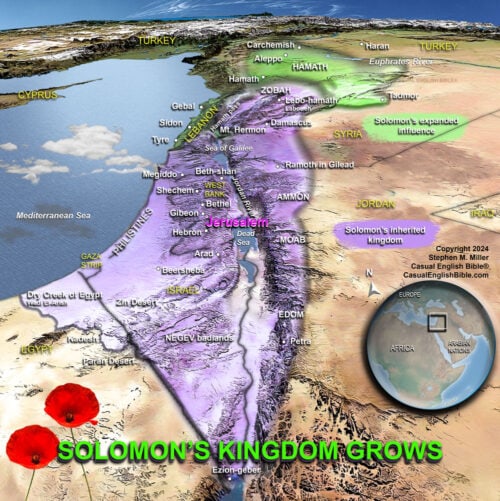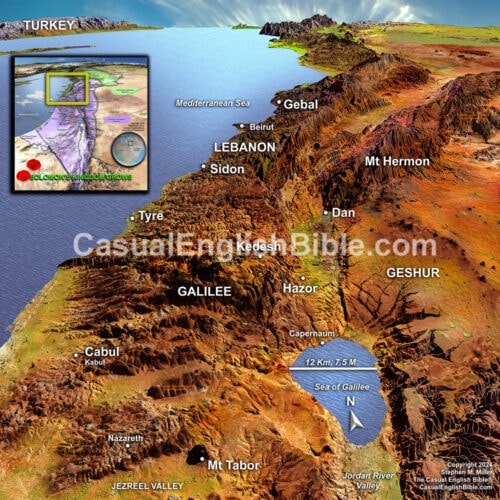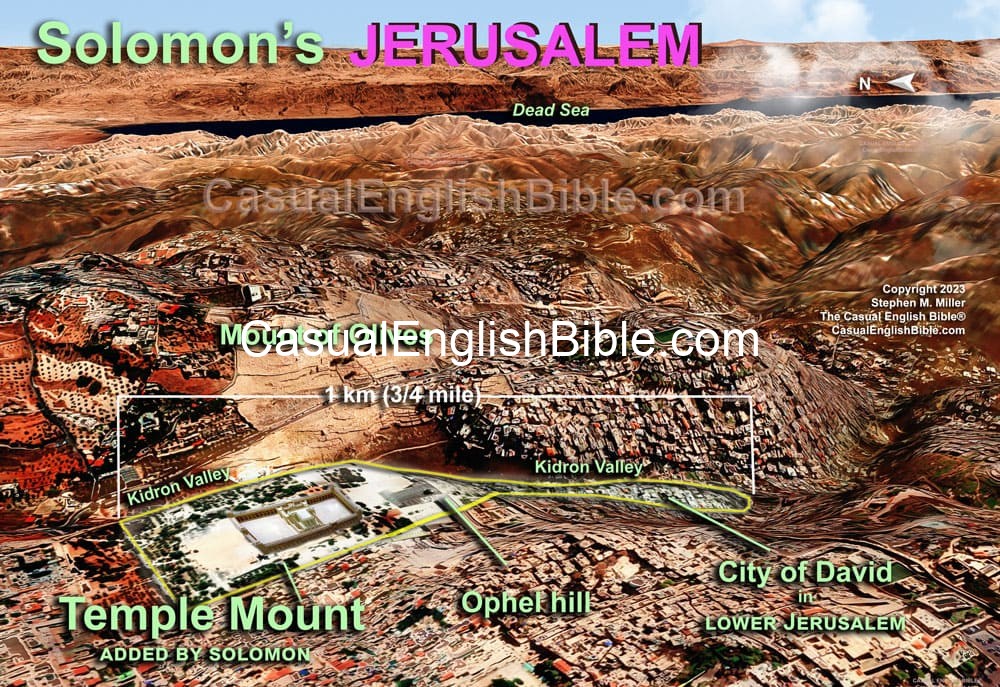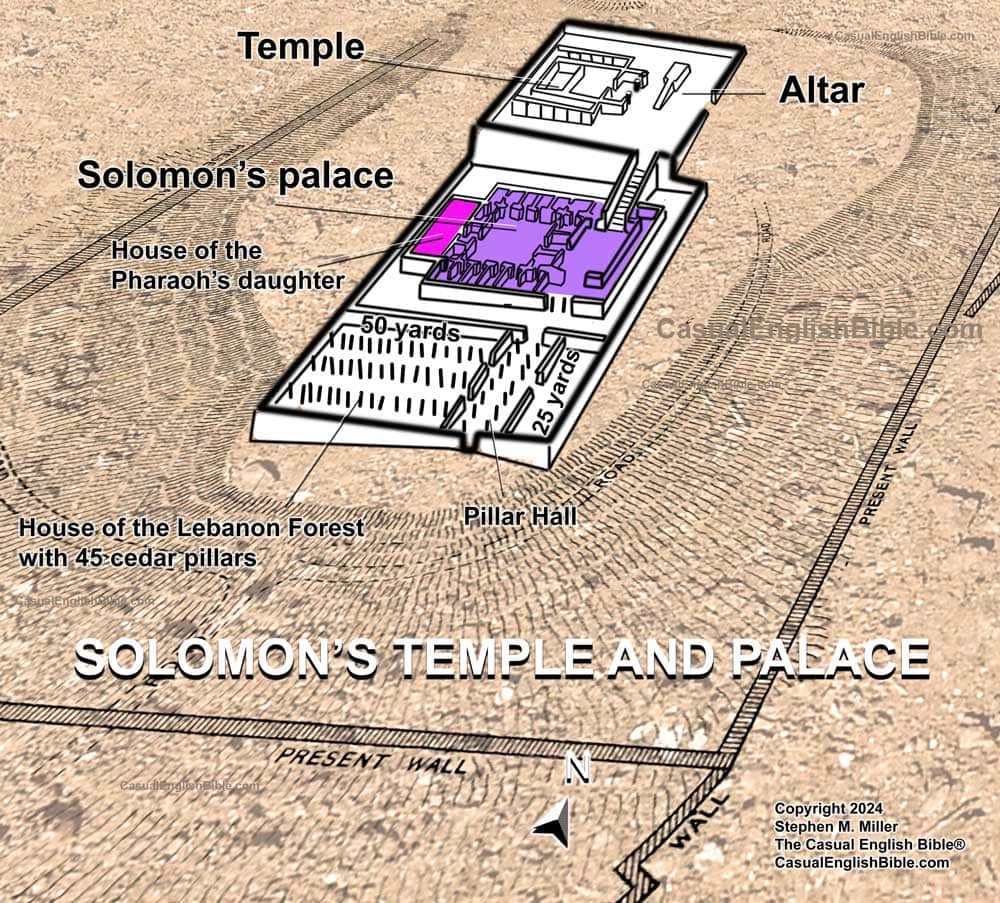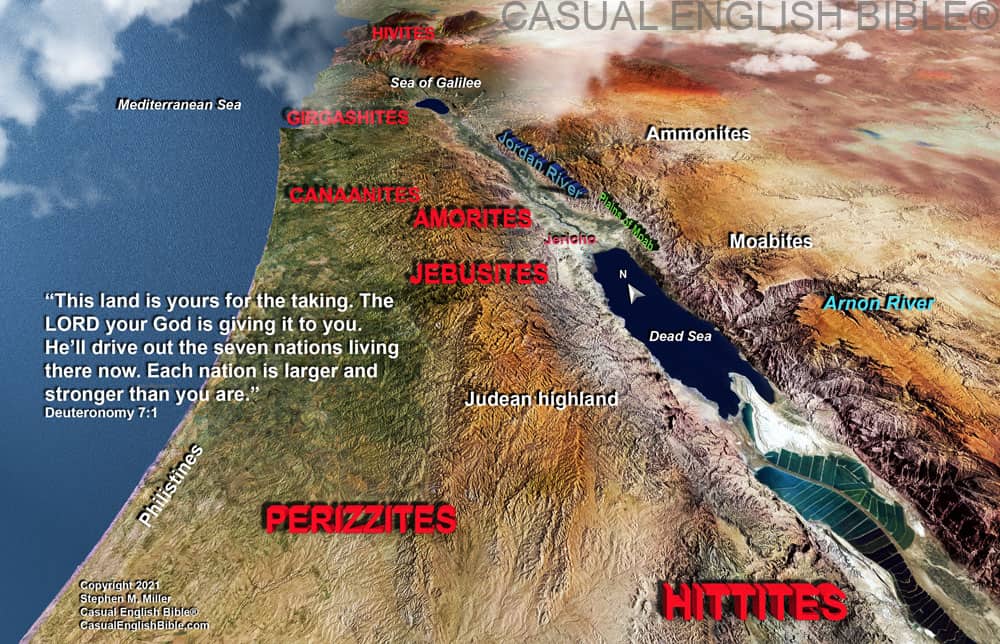2 Chronicles 8
Solomon, city builder with slave labor
Solomon’s accomplishments
1 Kings 9:10-28 1It took Solomon’s workers 20 years [1] to build a house for the LORD and a house for the king: Temple and palace. 2But that’s not all Solomon built during that stretch. He also rebuilt the cities that King Hiram gave him, and he moved in some Israelite settlers.
3Solomon pushed northwest, invading and capturing Hamath-zobah. 4And he pushed northeast as well, where he gave the desert caravan stop in Tadmor a makeover, building it into a city. He also built storage facilities throughout the northern territory of Hamath. 5Solomon ordered extensive makeovers to the towns of Upper and Lower Beth-horon. He reinforced the city gates with metal bars that locked them. And he strengthened city walls.
6He upgraded the town of Baalath. Solomon created a network of storage cities along with cities for his battlegroup of chariots and for his cavalry. Solomon used forced labor to build anything and everything he wanted in Jerusalem and in the neighboring land of Lebanon and everywhere else under his control. Solomon enslaves immigrants
7There were people living in his kingdom who weren’t Israelites. There were Hittites, Amorites, Perizzites, Hivites, and Jebusites. 8Solomon enslaved them. These locals descended from Canaanites who survived Israel’s invasion. Israelite invaders attempted but failed to annihilate [2] the locals—men, women, and children. Solomon rounded up the leftover Canaanites and created a slave guild of builders. The same thing goes on even today. [3]
9Solomon didn’t treat his own people of Israel like that. Instead of forcing them into hard labor as slaves, he gave them jobs as soldiers, officials, commanders in the army, charioteers, and cavalry. 10Solomon assigned 250 officials to oversee the scattered crews of drafted workers.
11Solomon moved his wife, Pharaoh’s daughter, from her home in the City of David, in lower Jerusalem, to her home in the new palace complex Solomon built. He explained, “None of my wives will live any longer in King David’s palace. That home is holy now because the Box of the LORD [4] was kept there.
12Solomon sacrificed burnt offerings [5] at the altar in front of the entrance onto the Temple porch and into the sanctuary. 13He did this on schedule, as instructed in the laws Moses gave the people. The king sacrificed every Saturday Sabbath, every New Moon, which was the first day of the month, and at each of the annual festivals: Festival of Yeast-free bread, [6] Last Harvest Festival, [7] and Festival of Temporary Shelters [8] Priests on the job
14King David organized the priests and their Levite [9] associates into various divisions and ministry assignments, including guard duty at the Temple entrance gates. Solomon followed the model created by his father David, a man who had been devoted to God.
15Priests and Levites did what Solomon ordered. They didn’t push back against the king’s order about anything, including how to manage the Temple treasury.
16So, Solomon’s workers finished building the Temple. He oversaw each step of the way, starting with when they laid the foundation.
17Solomon took a trip south to Edom’s port city of Ezion-geber. That was close to Elath, on the Reed Sea. [10] 18King Hiram sent some ships and some of his experienced sailors. [11] They sailed with Solomon’s men and worked side-by-side on the ships. They sailed to Ophir [12] and came back with about 16 [13] tons of gold for Solomon. Footnotes
18:1It took seven years to build the Temple (6:38) and thirteen to build the palace (7:1).
28:8The Hebrew term to describe this is herem, “annihilate.” This is the same term used to describe what Joshua and the invading Israelites did to the Canaanites. Moses had told them, “When the LORD your God gives them to you, you’ll need to finish them off. After you defeat them in battle, wipe them out by killing them all. Don’t make any peace treaty with them. Don’t show them mercy” (Deuteronomy 7:2). Scholars describe this as a “curse of war” or a “ban.” The “ban” means that when soldiers conquer a city, for example, they are banned from keeping anything for themselves—everything in the city is under the curse of war and must die. This kind of vow in ancient times was considered irrevocable and irredeemable. You couldn’t take it back. And nothing of the enemy was allowed to live. Everything in the city was devoted to God, much like sacrificial animals that are slaughtered and burned. “It’s a vow of devotion. If something is devoted to the LORD—whether human, animal, or land—you can’t have it back. If you devote something in this unique way, it’s holy and it stays holy because it belongs to the LORD…You can’t reverse that. You can’t buy back that person’s life. That person is doomed to die” (Leviticus 27:28-29). People today might describe this kind of reaction to outsiders as “xenophobia,” which is prejudice against all others. And they might call the slaughter “genocide.” Those defending the Israelites might point readers to the source of the order, reportedly coming from God, and delivered by Moses. Many Bible scholars struggle over understanding how or why God would give such an apparently terrorizing order to Joshua and the others. Yet, it was a common approach to taking someone’s land and to making sure they never got a chance to take it back.
38:8For more recent parallels, people from Africa—slaves and free—built the American president’s house, the White House. In the United Kingdom and France, slaves built many churches, including the Notre Dame Cathedral, terribly damaged in a fire in 2019.
48:11Better known as the Ark of the Covenant, a sacred chest that held the Ten Commandments. It was Israel’s most revered object, and it was kept in the most sacred room inside the worship center, a room sometimes known as the Holy of Holies or the Most Holy Place. For a description, see Exodus 23.
58:12A burnt offering was the most common animal sacrifice. Worshipers burned the entire animal. See Leviticus 1.
68:13The Hebrew word is pesach (PAY sock). It refers to the annual Passover meal today called a seder (SAY dur), which means “order.” That’s a reference to the fact that the Passover meal is eaten as a meticulously detailed ritual of reading, remembering, and prayer. The word “Passover” comes from the story of God or one of his angels killing the Egyptian firstborn, but “passing over” Hebrew homes with animal blood on the doorframes. Passover is one of the most revered holidays for Jewish people. They observe the festival around Eastertime, in March or April. Jesus went to Jerusalem to observe Passover, when he was arrested and crucified.
78:13This harvest festival goes by several names. The Hebrew name here is literally, Festival of Weeks, using a Hebrew word based on the seven-week timeline. Many Jews today call the festival by its Hebrew name Shavuot, meaning “weeks.” In New Testament times it became known as the Festival of Pentecost, from the Greek word meaning “fiftieth.” Jews celebrated the festival 50 days (7 weeks, hence the name) after Passover. Passover is when the Romans crucified Jesus. For more background, see Exodus 34:22-27 and Leviticus 23:15-22.
88:13It’s often called the Festival of Shelters or Festival of Booths. In Exodus, it was the last harvest festival of the year. That’s when farmers harvested late-season crops such as grapes, figs, and olives (Exodus 23:16). This was in the late summer and early autumn. The Hebrew word describing the festival here is sukka. It can mean tent, canopy, or temporary shelter. Moses said God wanted the Israelites to observe this festival by building temporary shelters and living in them for seven days “so you and your descendants will remember that the people of Israel I led out of Egyptian slavery once lived in shelters like this” (Leviticus 23:43).
98:14Levites were people from the tribe of Levi. All Israel’s priests and auxiliary help in matters of worship came from the tribe of Levi. Levites were either priests or priestly associates such as musicians, artisans, or security guards at the Temple.
108:17The location is the Gulf of Aqaba, the eastern rabbit ear of the Red Sea. But the writer calls it the “Reed Sea” and not the Red Sea. The Hebrew words are yam suph, “sea reeds.” In the story of Moses and the Hebrew refugees, they escape through a path God makes in this body of water. Scholars usually track Moses and the Hebrews escaping Egypt by walking southeast, out of the Nile Delta fields and toward the Red Sea and the Sinai Peninsula. They would have passed through lake regions along what is now the Suez Canal, which connects the Red Sea to the Mediterranean Sea. These lakes and ponds reportedly had reeds growing along the banks, like the ones the Bible says grew along the Nile River and helped anchor Baby Moses in a basket (Exodus 2:3). But all of this is on or near the western rabbit ear of the Red Sea, across the Sinai Peninsula. Why the writer calls this eastern side by the same term is a mystery. Maybe there were lots of reeds. Or maybe he was connecting this to Israel’s early history with the same body of water. An escape route for refugees became a gold mine for descendants of those refugees.
118:18Phoenicians of the Mediterranean coastal territory around Tyre and Sidon show up in history as some of the most experienced sailors and seafaring merchants of the time.
128:18Location of Ophir is unknown. But it was famous for producing the finest gold. A broken piece of pottery found near Tel Aviv and dated to the 700s BC, a couple centuries after kings David and Solomon, confirms that Ophir was a location from which gold was exported. The fragment reads “30 shekels…gold of Ophir for Beth-Horon.” Scholars have speculated that the gold was somewhere in Arabia or Africa or India. That narrows the search from seven continents to three.
138:18In ancient Hebrew measure of weight, sailors came home with 420 “talents” of gold. The weight of a talent varied in time and location. But at this time and location, some scholars are guessing one talent equals 75 pounds or 34 kilograms. Multiply it by 420, that’s 31,500 pounds (about 14,300 kg). It would take about 18 pickup trucks to haul that much weight. Or 210 little red wagons.
Discussion Questions
- Sorry, there are currently no questions for this chapter.
Videos
3Solomon pushed northwest, invading and capturing Hamath-zobah. 4And he pushed northeast as well, where he gave the desert caravan stop in Tadmor a makeover, building it into a city. He also built storage facilities throughout the northern territory of Hamath. 5Solomon ordered extensive makeovers to the towns of Upper and Lower Beth-horon. He reinforced the city gates with metal bars that locked them. And he strengthened city walls.
6He upgraded the town of Baalath. Solomon created a network of storage cities along with cities for his battlegroup of chariots and for his cavalry. Solomon used forced labor to build anything and everything he wanted in Jerusalem and in the neighboring land of Lebanon and everywhere else under his control.
Solomon enslaves immigrants
7There were people living in his kingdom who weren’t Israelites. There were Hittites, Amorites, Perizzites, Hivites, and Jebusites. 8Solomon enslaved them. These locals descended from Canaanites who survived Israel’s invasion. Israelite invaders attempted but failed to annihilate [2] the locals—men, women, and children. Solomon rounded up the leftover Canaanites and created a slave guild of builders. The same thing goes on even today. [3]9Solomon didn’t treat his own people of Israel like that. Instead of forcing them into hard labor as slaves, he gave them jobs as soldiers, officials, commanders in the army, charioteers, and cavalry. 10Solomon assigned 250 officials to oversee the scattered crews of drafted workers.
11Solomon moved his wife, Pharaoh’s daughter, from her home in the City of David, in lower Jerusalem, to her home in the new palace complex Solomon built. He explained, “None of my wives will live any longer in King David’s palace. That home is holy now because the Box of the LORD [4] was kept there.
12Solomon sacrificed burnt offerings [5] at the altar in front of the entrance onto the Temple porch and into the sanctuary. 13He did this on schedule, as instructed in the laws Moses gave the people. The king sacrificed every Saturday Sabbath, every New Moon, which was the first day of the month, and at each of the annual festivals: Festival of Yeast-free bread, [6] Last Harvest Festival, [7] and Festival of Temporary Shelters [8]
Priests on the job
14King David organized the priests and their Levite [9] associates into various divisions and ministry assignments, including guard duty at the Temple entrance gates. Solomon followed the model created by his father David, a man who had been devoted to God.15Priests and Levites did what Solomon ordered. They didn’t push back against the king’s order about anything, including how to manage the Temple treasury.
16So, Solomon’s workers finished building the Temple. He oversaw each step of the way, starting with when they laid the foundation.
17Solomon took a trip south to Edom’s port city of Ezion-geber. That was close to Elath, on the Reed Sea. [10] 18King Hiram sent some ships and some of his experienced sailors. [11] They sailed with Solomon’s men and worked side-by-side on the ships. They sailed to Ophir [12] and came back with about 16 [13] tons of gold for Solomon.
Footnotes
It took seven years to build the Temple (6:38) and thirteen to build the palace (7:1).
The Hebrew term to describe this is herem, “annihilate.” This is the same term used to describe what Joshua and the invading Israelites did to the Canaanites. Moses had told them, “When the LORD your God gives them to you, you’ll need to finish them off. After you defeat them in battle, wipe them out by killing them all. Don’t make any peace treaty with them. Don’t show them mercy” (Deuteronomy 7:2). Scholars describe this as a “curse of war” or a “ban.” The “ban” means that when soldiers conquer a city, for example, they are banned from keeping anything for themselves—everything in the city is under the curse of war and must die. This kind of vow in ancient times was considered irrevocable and irredeemable. You couldn’t take it back. And nothing of the enemy was allowed to live. Everything in the city was devoted to God, much like sacrificial animals that are slaughtered and burned. “It’s a vow of devotion. If something is devoted to the LORD—whether human, animal, or land—you can’t have it back. If you devote something in this unique way, it’s holy and it stays holy because it belongs to the LORD…You can’t reverse that. You can’t buy back that person’s life. That person is doomed to die” (Leviticus 27:28-29). People today might describe this kind of reaction to outsiders as “xenophobia,” which is prejudice against all others. And they might call the slaughter “genocide.” Those defending the Israelites might point readers to the source of the order, reportedly coming from God, and delivered by Moses. Many Bible scholars struggle over understanding how or why God would give such an apparently terrorizing order to Joshua and the others. Yet, it was a common approach to taking someone’s land and to making sure they never got a chance to take it back.
For more recent parallels, people from Africa—slaves and free—built the American president’s house, the White House. In the United Kingdom and France, slaves built many churches, including the Notre Dame Cathedral, terribly damaged in a fire in 2019.
Better known as the Ark of the Covenant, a sacred chest that held the Ten Commandments. It was Israel’s most revered object, and it was kept in the most sacred room inside the worship center, a room sometimes known as the Holy of Holies or the Most Holy Place. For a description, see Exodus 23.
A burnt offering was the most common animal sacrifice. Worshipers burned the entire animal. See Leviticus 1.
The Hebrew word is pesach (PAY sock). It refers to the annual Passover meal today called a seder (SAY dur), which means “order.” That’s a reference to the fact that the Passover meal is eaten as a meticulously detailed ritual of reading, remembering, and prayer. The word “Passover” comes from the story of God or one of his angels killing the Egyptian firstborn, but “passing over” Hebrew homes with animal blood on the doorframes. Passover is one of the most revered holidays for Jewish people. They observe the festival around Eastertime, in March or April. Jesus went to Jerusalem to observe Passover, when he was arrested and crucified.
This harvest festival goes by several names. The Hebrew name here is literally, Festival of Weeks, using a Hebrew word based on the seven-week timeline. Many Jews today call the festival by its Hebrew name Shavuot, meaning “weeks.” In New Testament times it became known as the Festival of Pentecost, from the Greek word meaning “fiftieth.” Jews celebrated the festival 50 days (7 weeks, hence the name) after Passover. Passover is when the Romans crucified Jesus. For more background, see Exodus 34:22-27 and Leviticus 23:15-22.
It’s often called the Festival of Shelters or Festival of Booths. In Exodus, it was the last harvest festival of the year. That’s when farmers harvested late-season crops such as grapes, figs, and olives (Exodus 23:16). This was in the late summer and early autumn. The Hebrew word describing the festival here is sukka. It can mean tent, canopy, or temporary shelter. Moses said God wanted the Israelites to observe this festival by building temporary shelters and living in them for seven days “so you and your descendants will remember that the people of Israel I led out of Egyptian slavery once lived in shelters like this” (Leviticus 23:43).
Levites were people from the tribe of Levi. All Israel’s priests and auxiliary help in matters of worship came from the tribe of Levi. Levites were either priests or priestly associates such as musicians, artisans, or security guards at the Temple.
The location is the Gulf of Aqaba, the eastern rabbit ear of the Red Sea. But the writer calls it the “Reed Sea” and not the Red Sea. The Hebrew words are yam suph, “sea reeds.” In the story of Moses and the Hebrew refugees, they escape through a path God makes in this body of water. Scholars usually track Moses and the Hebrews escaping Egypt by walking southeast, out of the Nile Delta fields and toward the Red Sea and the Sinai Peninsula. They would have passed through lake regions along what is now the Suez Canal, which connects the Red Sea to the Mediterranean Sea. These lakes and ponds reportedly had reeds growing along the banks, like the ones the Bible says grew along the Nile River and helped anchor Baby Moses in a basket (Exodus 2:3). But all of this is on or near the western rabbit ear of the Red Sea, across the Sinai Peninsula. Why the writer calls this eastern side by the same term is a mystery. Maybe there were lots of reeds. Or maybe he was connecting this to Israel’s early history with the same body of water. An escape route for refugees became a gold mine for descendants of those refugees.
Phoenicians of the Mediterranean coastal territory around Tyre and Sidon show up in history as some of the most experienced sailors and seafaring merchants of the time.
Location of Ophir is unknown. But it was famous for producing the finest gold. A broken piece of pottery found near Tel Aviv and dated to the 700s BC, a couple centuries after kings David and Solomon, confirms that Ophir was a location from which gold was exported. The fragment reads “30 shekels…gold of Ophir for Beth-Horon.” Scholars have speculated that the gold was somewhere in Arabia or Africa or India. That narrows the search from seven continents to three.
In ancient Hebrew measure of weight, sailors came home with 420 “talents” of gold. The weight of a talent varied in time and location. But at this time and location, some scholars are guessing one talent equals 75 pounds or 34 kilograms. Multiply it by 420, that’s 31,500 pounds (about 14,300 kg). It would take about 18 pickup trucks to haul that much weight. Or 210 little red wagons.
Discussion Questions
- Sorry, there are currently no questions for this chapter.





